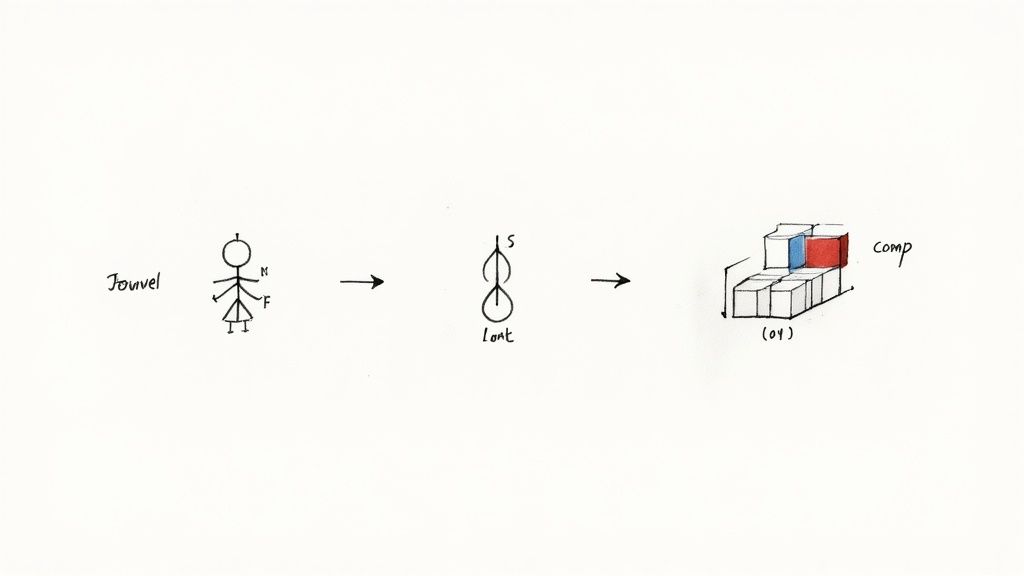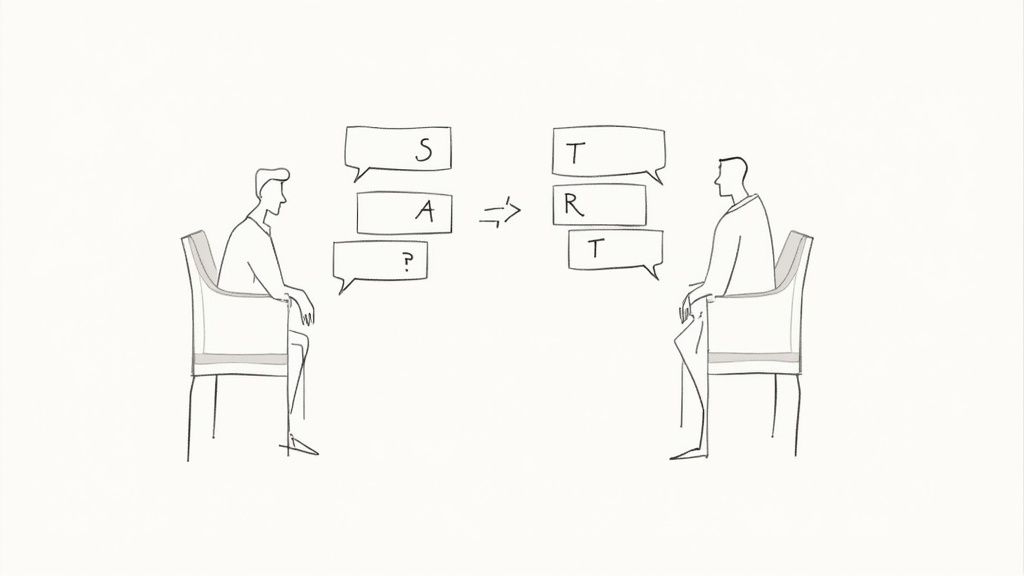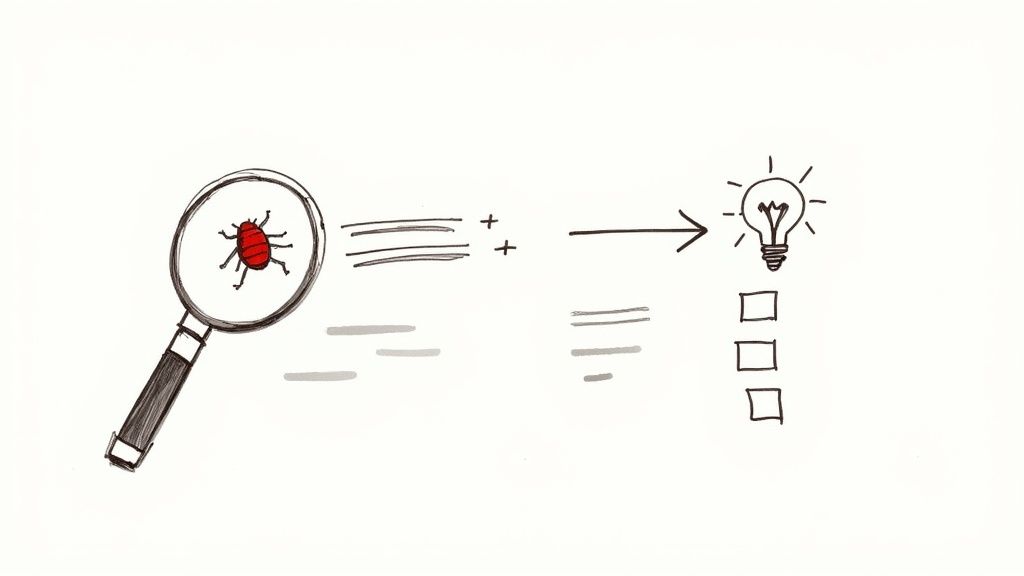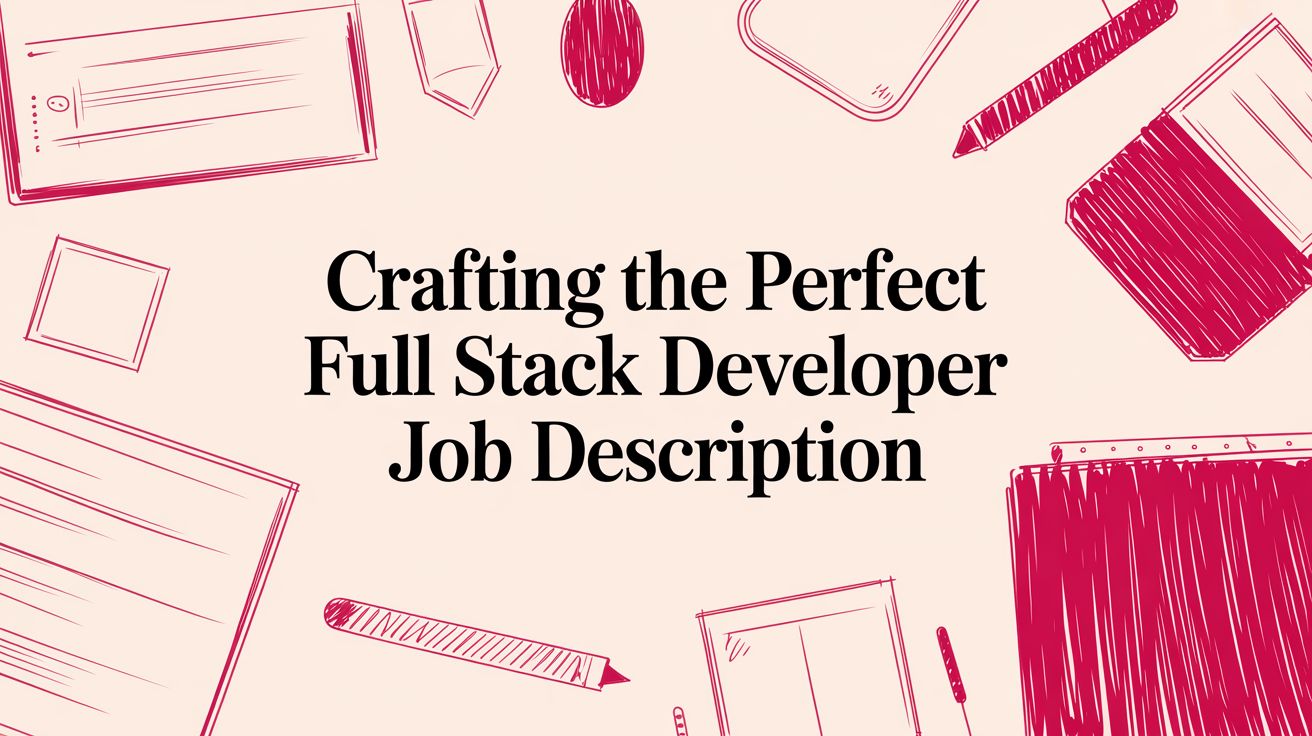10 Essential Software Engineer Interview Questions for 2025
Max
Cracking the software engineer interview is about more than just knowing the right answer; it’s about showcasing your problem-solving process, architectural thinking, and collaborative spirit. The modern set of software engineer interview questions has evolved, blending classic algorithm challenges with complex system design scenarios and critical behavioral assessments. This guide breaks down the 10 essential question categories you’ll face, from foundational data structures and algorithms to debugging real-world systems and designing scalable APIs.
We’ll provide actionable tips, sample questions, and the strategic context you need not just to answer, but to impress. Each section is designed to give you a clear roadmap for what interviewers are really looking for when they ask about topics like object-oriented design, concurrency, or your past professional experiences. This comprehensive approach ensures you are prepared for the full spectrum of technical and soft-skill evaluations.
While this article focuses on the technical side, it’s crucial to prepare for general interview scenarios as well. To broaden your preparation, exploring a variety of essential job interview practice questions can help you build confidence for non-technical rounds and present yourself as a well-rounded candidate. Whether you are a recent graduate or a seasoned professional aiming for a senior role, mastering these diverse areas will equip you for any challenge. Let’s dive into the questions that will define your next career move.
1. Data Structures and Algorithms
Data Structures and Algorithms (DSA) questions are the cornerstone of technical interviews for software engineers. These questions are designed to evaluate a candidate’s fundamental computer science knowledge and their ability to apply it to solve complex problems efficiently. Interviewers aren’t just looking for a correct answer; they’re assessing your problem-solving process, coding style, and ability to analyze performance.
This category tests your understanding of core concepts like arrays, linked lists, hash maps, trees, and graphs, alongside algorithms for searching, sorting, and dynamic programming. Companies like Google and Meta (formerly Facebook) famously use these types of software engineer interview questions to gauge a candidate’s ability to write optimized, scalable, and robust code.

Why It’s a Top Interview Question
DSA questions are critical because they directly predict a candidate’s potential to handle real-world engineering challenges. An engineer who understands Big O notation (time and space complexity) can make informed decisions that prevent performance bottlenecks in large-scale applications. For example, choosing a hash map (O(1) average time complexity) over an array search (O(n)) for frequent lookups can drastically improve system speed.
How to Prepare for DSA Questions
Success in these interviews comes down to consistent, structured practice. Don’t just memorize solutions; focus on understanding the underlying patterns.
- Consistent Practice: Dedicate time daily or weekly to solving problems on platforms like LeetCode or HackerRank. Start with easy problems to build confidence and gradually move to medium and hard levels.
- Master Key Patterns: Recognize common problem patterns such as Two Pointers, Sliding Window, and Breadth-First Search (BFS). Identifying a pattern quickly allows you to apply a known algorithmic template instead of starting from scratch.
- Verbalize Your Thought Process: Always talk through your solution aloud during the interview. Explain the tradeoffs you’re considering, why you chose a particular data structure, and how you plan to handle edge cases. This gives the interviewer valuable insight into your analytical skills.
- Analyze Complexity: After coding a solution, be prepared to discuss its time and space complexity. This demonstrates a deeper level of understanding and is a mandatory part of any FAANG-level technical screen.
2. System Design
System design questions are open-ended conversations where candidates are asked to architect a large-scale system like YouTube or Uber. These questions evaluate your ability to think at a high level, analyze trade-offs, and build solutions that are scalable, reliable, and maintainable. Interviewers are less concerned with a single “correct” answer and more interested in your thought process, your justification for design choices, and your ability to navigate ambiguity.
This category is especially critical for mid-level to senior engineering roles. Companies like Amazon, Netflix, and Google use these software engineer interview questions to assess a candidate’s experience with real-world architectural challenges, covering everything from databases and caching strategies to load balancing and microservices.

Why It’s a Top Interview Question
System design interviews directly reflect the day-to-day responsibilities of a senior engineer. The ability to design a robust architecture determines a product’s success, performance, and ability to scale to millions of users. An engineer who can effectively discuss trade-offs, like choosing between SQL and NoSQL databases or deciding on a message queue, demonstrates the maturity needed to lead complex projects. This aligns closely with broader software development best practices that emphasize building for the long term.
How to Prepare for System Design Questions
Preparation for system design involves understanding common architectural patterns and being able to articulate your design decisions clearly.
- Follow a Structured Approach: Start by gathering functional and non-functional requirements (e.g., scale, latency). Then, create a high-level design and progressively drill down into specific components.
- Draw and Communicate: Use a whiteboard or digital tool to draw diagrams. This helps clarify your thinking and keeps the interviewer engaged. Explain your choices and the trade-offs at each step.
- Master Core Components: Gain a solid understanding of key building blocks like load balancers, CDNs, databases (SQL vs. NoSQL), caches (e.g., Redis, Memcached), and message queues (e.g., Kafka, RabbitMQ).
- Study Existing Architectures: Analyze how popular systems like Twitter or Netflix are built. Resources like the book System Design Interview by Alex Xu and his ByteByteGo channel are excellent for this.
3. Behavioral and Soft Skills
Beyond pure coding ability, companies want to hire engineers who are effective collaborators, communicators, and problem-solvers in a team setting. Behavioral and soft skills questions are designed to uncover these traits by asking you to recount past experiences. Instead of hypothetical scenarios, these software engineer interview questions focus on how you actually handled situations involving conflict, failure, leadership, and teamwork.
Top tech companies place a heavy emphasis on cultural fit and interpersonal skills. For example, Amazon bases its behavioral interviews on its 14 Leadership Principles, Google assesses “Googleyness,” and Microsoft looks for a “growth mindset.” The goal is to see if your values and work style align with the company’s culture and whether you can contribute positively to their engineering environment.

Why It’s a Top Interview Question
Behavioral questions are critical because technical skills alone do not guarantee success. An engineer who can’t communicate their ideas, receive feedback, or collaborate effectively can hinder an entire team’s progress. These questions provide a window into your personality, work ethic, and ability to navigate the complex social dynamics of a modern workplace. In many ways, mastering non-technical aspects, such as through effective communication skills training, is just as crucial as your technical prowess. For remote roles, these skills are even more important, as highlighted in these essential remote interview tips.
How to Prepare for Behavioral Questions
Success in behavioral interviews depends on thoughtful preparation and structured storytelling. Your goal is to present compelling narratives that showcase your best qualities.
- Use the STAR Method: Structure your answers using the Situation, Task, Action, Result (STAR) method. This framework ensures your stories are clear, concise, and impactful, guiding the interviewer through the context, your responsibility, the specific steps you took, and the measurable outcome.
- Prepare 5-7 Core Stories: Brainstorm key experiences from your career that highlight different strengths: leadership, conflict resolution, dealing with failure, and teamwork. Prepare detailed stories for each that can be adapted to various questions.
- Focus on “I,” Not “We”: While acknowledging the team is important, the interviewer wants to know what you did. Clearly articulate your specific contributions, decisions, and actions that led to the result.
- Tailor to Company Values: Research the company’s core values or leadership principles (like Amazon’s). Align your stories to demonstrate how you embody those specific traits, showing you are a strong cultural fit.
4. Coding Round (Live Implementation)
The live coding round is a practical, hands-on assessment where candidates write functional code in real-time. Often conducted on shared platforms like CoderPad or HackerRank, this interview format moves beyond theoretical knowledge to evaluate your practical programming skills, problem-solving abilities under pressure, and coding hygiene.
This type of software engineer interview question is designed to simulate a pair-programming environment. The interviewer observes as you translate a problem description into a working solution, assessing everything from your syntax and debugging process to your ability to write clean, testable code. Companies like Stripe and Airbnb use these rounds to see how you would perform on a typical engineering task.
Why It’s a Top Interview Question
Live coding rounds reveal how a candidate bridges the gap between theory and implementation. It’s one thing to describe an algorithm on a whiteboard, but another to implement it flawlessly in a shared IDE while an interviewer watches. This format effectively tests your fluency in a chosen programming language, your attention to detail, and your ability to handle edge cases.
An engineer who can write pseudocode, implement a clean solution, and then systematically test it demonstrates a mature and professional workflow. It shows the interviewer you can be trusted to write production-quality code.
How to Prepare for Live Coding Questions
Success in a live coding round is about both technical skill and communication strategy. Your goal is to showcase your thought process as much as the final code.
- Familiarize Yourself with the Platform: Most companies will tell you which platform they use (e.g., CoderPad, HackerRank). Spend time on these platforms beforehand to get comfortable with the interface, compiler, and debugging features.
- Communicate Continuously: Never code in silence. Talk through your initial thoughts, explain the logic behind your pseudocode, and articulate why you’re choosing specific variables or control flows. This keeps the interviewer engaged and helps them follow your reasoning.
- Write Tests First (or Last): Before declaring your solution complete, write a few test cases. Include common inputs, empty inputs, and edge cases to prove your code is robust. This proactive testing mindset is highly valued.
- Start Simple, Then Refactor: Don’t aim for the most optimized solution immediately. It’s often better to implement a correct, brute-force solution first and then discuss or implement optimizations. This demonstrates a pragmatic approach to problem-solving. Find out more by reading our guide on how to prepare for coding interviews.
5. Object-Oriented Design (OOD)
Object-Oriented Design (OOD) questions evaluate your ability to architect a software system using the principles of object-oriented programming. These problems require you to think abstractly, designing classes, interfaces, and their relationships to create a flexible, scalable, and maintainable system. Interviewers are assessing your understanding of core OOP concepts like encapsulation, inheritance, abstraction, and polymorphism.
This category of software engineer interview questions moves beyond single algorithms to test your broader architectural thinking. Companies like Microsoft and Adobe frequently use OOD questions for mid to senior-level roles, where designing robust components and systems is a daily responsibility. The goal is to see how you would model a real-world system, such as a parking lot, an ATM, or a library management system, in code.
Why It’s a Top Interview Question
OOD proficiency is a strong indicator of an engineer’s ability to write clean, modular, and reusable code. In large-scale applications, poor design choices lead to technical debt, making the system difficult to modify and extend. An engineer skilled in OOD can create components that are loosely coupled and highly cohesive, which is crucial for building software that can evolve over time without breaking. This architectural mindset is exactly what companies look for when hiring for roles that involve significant design responsibilities.
How to Prepare for OOD Questions
Success in OOD interviews hinges on a structured approach to system modeling and clear communication of your design decisions.
- Clarify Requirements: Start by asking clarifying questions to fully understand the system’s scope. What are the core use cases? Who are the actors? What constraints exist? Don’t make assumptions.
- Identify Core Objects: Identify the main entities or objects in the system. For a parking lot system, this might include
Vehicle,ParkingSpot,Ticket, andGate. Define their attributes and primary functions. - Establish Relationships: Determine how the objects interact. For example, does a
Vehiclehave aTicket? Does aParkingLotcontain multipleParkingSpots? Use UML diagrams or simple sketches to visualize these relationships. - Apply Design Patterns: Where appropriate, use established design patterns (e.g., Singleton, Factory, Strategy) to solve common problems. Mentioning and justifying the use of a pattern demonstrates senior-level thinking.
- Discuss Trade-offs: Articulate the design choices you made and their trade-offs. Explain why you chose inheritance over composition, or why you used an abstract class instead of an interface. This shows the interviewer you are a thoughtful and deliberate designer.
6. Database and SQL
Database and SQL questions evaluate a candidate’s ability to store, retrieve, and manage data efficiently, a core responsibility for many software engineering roles. These questions test proficiency in SQL, schema design, query optimization, and the fundamental differences between relational (SQL) and non-relational (NoSQL) databases. Interviewers are looking for engineers who can think about data scalability, integrity, and performance from the ground up.
This category is crucial for backend, data engineering, and full-stack positions. Companies like Amazon and Google often include complex SQL queries or database design scenarios in their interviews to assess how a candidate handles large-scale data. For instance, you might be asked to design a database schema for a social media platform or optimize a slow query that impacts user experience.
Why It’s a Top Interview Question
Proficiency in databases is non-negotiable for roles that involve data persistence. An engineer who writes inefficient queries can bring an entire application to a halt, while one who designs a poor schema can create insurmountable scaling problems down the line. These software engineer interview questions reveal whether a candidate can build systems that are not only functional but also performant and maintainable. Understanding concepts like indexing, normalization, and transaction management directly translates to building reliable and fast applications.
How to Prepare for Database and SQL Questions
Practical application and a solid grasp of theoretical concepts are key to acing these questions. Focus on both writing queries and understanding how databases work under the hood.
- Master SQL Fundamentals: Go beyond simple
SELECTstatements. Practice complexJOINoperations (INNER, LEFT, RIGHT), subqueries, aggregations withGROUP BY, and window functions. Be comfortable writing queries that answer intricate business questions. - Understand Schema Design: Practice designing database schemas for common applications (e.g., e-commerce, social media). Be prepared to discuss normalization (1NF, 2NF, 3NF) and when it might be appropriate to de-normalize for performance.
- Learn Query Optimization: Know how to use
EXPLAINorEXPLAIN ANALYZEto inspect a query execution plan. Understand what indexes are, why they speed up queries, and the tradeoffs involved (e.g., slower write times). - Know SQL vs. NoSQL: Articulate the key differences between relational databases like PostgreSQL and NoSQL databases like MongoDB or DynamoDB. Be ready to explain which you would choose for a given scenario and justify your decision based on consistency, availability, and scalability requirements. This is especially relevant for roles where you can find remote SQL developer jobs.
7. API Design and REST
API Design and REST questions evaluate a candidate’s ability to create clean, scalable, and intuitive interfaces between different software components. These software engineer interview questions focus on the principles of REST (Representational State Transfer), HTTP protocols, and the practical challenges of building services that are easy for client applications to consume and maintain. Interviewers use these questions to assess your architectural thinking and understanding of how systems communicate in a distributed environment.
This category tests your knowledge of designing resource-oriented URLs, correctly using HTTP methods (GET, POST, PUT, DELETE), implementing proper status codes, and handling concerns like versioning, authentication, and rate limiting. Companies with extensive microservices architectures or public-facing platforms, such as Google, Amazon, and Stripe, heavily emphasize API design to ensure consistency and reliability across their ecosystems.
Why It’s a Top Interview Question
API design is a critical skill for backend and full-stack engineers, as poorly designed APIs can lead to confusing developer experiences, performance issues, and security vulnerabilities. An engineer who understands RESTful principles can build services that are decoupled, scalable, and self-descriptive. For example, using appropriate HTTP status codes like 404 Not Found or 429 Too Many Requests provides clear, machine-readable feedback to clients, making systems more robust and easier to debug.
How to Prepare for API Design Questions
Strong API design skills are developed by understanding best practices and thinking from the perspective of the API consumer.
- Design Around Resources: Structure your API around nouns (resources) like
/usersor/products, not verbs (actions) like/getUsers. Use HTTP methods to specify the action to be performed on that resource (e.g.,GET /users/123). - Use HTTP Methods Correctly: Understand idempotency and safety.
GETshould be safe (no side effects), whilePUTandDELETEshould be idempotent (multiple identical requests have the same effect as one). - Plan for Evolution: Discuss versioning strategies, such as using a URI path (
/v1/products) or a custom request header. This demonstrates foresight and an understanding that APIs change over time. - Think About the Details: Be ready to discuss practical considerations like pagination for large datasets, filtering and sorting parameters, and a consistent error-handling format. A well-designed API contract makes the developer experience significantly better.
8. Web Development and Frontend
Web Development and Frontend questions assess a candidate’s ability to build responsive, interactive, and high-performance user interfaces. These software engineer interview questions cover a wide spectrum of technologies, including HTML, CSS, JavaScript, browser APIs, and modern frontend frameworks like React or Vue. Interviewers use them to evaluate practical skills in DOM manipulation, asynchronous programming, state management, and debugging.
This category is crucial for frontend and full-stack roles. Companies like Netflix and Airbnb heavily emphasize frontend expertise, as a seamless user experience is core to their product. They test not just for framework knowledge but for a deep understanding of how the web works, from the event loop to the browser rendering pipeline.
Why It’s a Top Interview Question
Frontend engineering directly impacts user engagement and business success. A candidate who can optimize web performance, ensure accessibility, and build a robust UI is invaluable. For example, understanding how to handle asynchronous operations with Promises or async/await is critical for fetching data without freezing the user’s browser. These questions reveal a candidate’s ability to create the sophisticated web applications users expect today.
How to Prepare for Frontend Questions
A strong foundation in web fundamentals is more important than memorizing framework-specific trivia. Focus on the core technologies that power the modern web.
- Master JavaScript Fundamentals: Before diving deep into frameworks, ensure you have a solid grasp of closures, prototypes, the
thiskeyword, and asynchronous JavaScript. These concepts are universal. - Understand the Browser: Learn about the Critical Rendering Path, the DOM, and how browsers parse and render a webpage. Use tools like Chrome DevTools to debug and analyze performance metrics like First Contentful Paint (FCP).
- Build Practical Components: Practice building common UI components from scratch, such as a modal, an autocomplete search bar, or a custom dropdown. This tests your HTML, CSS (Flexbox/Grid), and JavaScript skills simultaneously.
- Study State Management: Be prepared to discuss different state management strategies. Explain the pros and cons of local component state versus a global solution like Redux or Context API in a React-focused interview.
9. Problem-Solving and Debugging
Problem-solving and debugging questions present candidates with ambiguous, real-world scenarios designed to test their troubleshooting skills. Instead of a clean algorithmic puzzle, you might be given a situation like “our service latency has spiked by 20% in the last hour, how would you investigate?” The goal is to evaluate your methodical thinking, ability to form and test hypotheses, and how you navigate complex systems with incomplete information.
These software engineer interview questions are a staple in interviews for SRE (Site Reliability Engineering), DevOps, and senior engineering roles. Companies like Google and Amazon use them to simulate high-pressure production incidents, looking for engineers who can remain calm and systematically diagnose the root cause of a failure.

Why It’s a Top Interview Question
Modern software systems are incredibly complex, and failures are inevitable. An engineer’s value is often measured not just by the code they write, but by their ability to fix things when they break. These questions directly assess a candidate’s practical debugging skills, which are crucial for maintaining system health and reliability. A methodical troubleshooter can save a company from costly downtime by quickly identifying and resolving issues.
How to Prepare for Debugging Questions
Success in these interviews hinges on demonstrating a structured and logical approach to problem-solving.
- Ask Clarifying Questions First: Never jump straight to a solution. Start by gathering information. Ask about recent deployments, changes in traffic patterns, specific error messages, and available monitoring data.
- State Your Hypotheses: Articulate your theories before you start investigating. For example, say “My initial hypothesis is that a recent code change introduced a database query bottleneck. I’ll start by checking the deployment logs and database performance dashboards.”
- Think in Layers: Systematically consider all potential points of failure. Work your way through the stack: from the client/CDN, to the load balancer, application servers, databases, and other downstream services.
- Verbalize Your Reasoning: As with algorithms, talk through every step of your process. Explain why you are checking a specific log file or performance metric. This is also a good time to mention how a strong process, like the one outlined in these code review best practices, can prevent such bugs from reaching production.
10. Concurrency, Threading, and Async Programming
Concurrency questions evaluate your ability to write code that performs multiple tasks simultaneously, a critical skill for building modern, high-performance applications. These software engineer interview questions cover topics like multithreading, race conditions, deadlocks, and asynchronous programming models. Interviewers use them to assess your understanding of parallel execution, synchronization primitives (like mutexes and semaphores), and designing responsive systems.
This category is especially prominent in interviews for backend services, systems programming, and real-time applications. Companies that build high-throughput systems, such as financial trading platforms using Java or C++, or scalable web services using Go or Node.js, rely heavily on these concepts to maximize hardware utilization and handle massive user loads.
Why It’s a Top Interview Question
A deep understanding of concurrency is non-negotiable for senior and systems-level roles. A bug in concurrent code can lead to subtle, hard-to-reproduce issues like data corruption (race conditions) or complete system freezes (deadlocks). Engineers who can reason about thread safety and design correct concurrent systems are highly valued because they can build robust applications that are both fast and reliable, preventing catastrophic failures in production environments.
How to Prepare for Concurrency Questions
Success requires a strong theoretical foundation combined with practical application. You must go beyond definitions and understand the “why” behind different concurrency models and synchronization tools.
- Master Your Language’s Model: Deeply understand the concurrency features specific to your primary language. For Java, this means the
java.util.concurrentpackage; for Go, it’s goroutines and channels; for JavaScript, it’s the event loop, promises, andasync/await. - Understand Synchronization Primitives: Know the difference between a mutex, semaphore, and a monitor, and be able to explain when to use each one. Practice implementing classic synchronization problems like the Producer-Consumer or Dining Philosophers problem.
- Think About Race Conditions: For any code involving shared state, train yourself to proactively identify potential race conditions. Explain how you would use locks, atomic operations, or other mechanisms to make the code thread-safe.
- Discuss Tradeoffs: Be prepared to discuss the performance implications of your choices. For example, explain how excessive locking can reduce parallelism and lead to contention, and discuss alternatives like lock-free data structures.
Software Engineer Interview: 10-Topic Comparison
| Item | Complexity 🔄 | Resource requirements ⚡ | Expected outcomes ⭐ | Ideal use cases 📊 | Key advantages 💡 |
|---|---|---|---|---|---|
| Data Structures and Algorithms | Medium–High — focused algorithmic thinking | Low infra; high candidate prep time | Strong indicator of algorithmic & complexity skills ⭐⭐⭐⭐ | Entry to mid roles; FAANG coding filters | Objective, language‑agnostic, measurable |
| System Design | High — open‑ended with broad trade‑offs | Whiteboard/diagram time; senior interviewer expertise | Shows architectural judgment and trade‑off analysis ⭐⭐⭐⭐ | Senior/lead roles; large‑scale systems | Tests scalability thinking and communication |
| Behavioral and Soft Skills | Low–Medium — conversational and situational | Minimal tools; high candidate storytelling prep | Assesses communication, leadership, fit ⭐⭐⭐ | All levels; team/leadership hires | Reveals culture fit, collaboration style |
| Coding Round (Live Implementation) | Medium–High — real‑time full implementations | Shared IDE/platform; timed session | Validates practical coding, testing, debugging ⭐⭐⭐⭐ | Backend/frontend devs; language verification | Working code evidence; real‑time observation |
| Object‑Oriented Design (OOD) | Medium — class modeling and patterns | Whiteboard/editor; example scenarios | Measures design maturity and extensibility thinking ⭐⭐⭐ | Mid–senior roles in OO codebases | Evaluates maintainability and pattern use |
| Database and SQL | Medium — query logic and schema trade‑offs | SQL environment, sample data, EXPLAIN plans | Demonstrates data modeling and performance tuning ⭐⭐⭐⭐ | Backend, data engineering, analytics | Directly applicable; measurable optimizations |
| API Design and REST | Medium — protocol, versioning, security concerns | Diagrams/discussion; sample endpoint design | Evaluates API contracts, security, and UX ⭐⭐⭐ | Backend, microservices, API‑first teams | Focuses on consumer experience and scalability |
| Web Development and Frontend | Medium — broad surface (frameworks, DOM, CSS) | Browser tooling, framework setup, performance tests | Assesses UI, responsiveness, and performance ⭐⭐⭐ | Frontend and full‑stack roles | Practical, visual results; user‑facing skills |
| Problem‑Solving and Debugging | Medium — hypothesis‑driven, ambiguous scenarios | Logs, code snippets, access to runtime info | Reveals troubleshooting method and root‑cause analysis ⭐⭐⭐⭐ | SRE, DevOps, support, general engineering | Tests systematic approach and persistence |
| Concurrency, Threading & Async | High — subtle correctness and synchronization | Language/runtime tools; concurrency testing setup | Validates thread‑safety, latency and throughput thinking ⭐⭐⭐ | Systems programming, real‑time & backend services | Critical for performance/reliability; deep systems knowledge |
Your Next Steps to Interview Success
Navigating the landscape of software engineer interview questions can feel like preparing for a marathon. You’ve now seen the ten critical domains that define a comprehensive technical interview, from the foundational logic of Data Structures and Algorithms to the high-level architecture of System Design. This journey is not about rote memorization; it’s about building a versatile problem-solving toolkit.
Success hinges on your ability to connect these disparate areas. A seemingly simple coding challenge might hide an underlying concurrency issue. A system design question about a social media feed is also a question about API design and database schema choices. The most impressive candidates are those who can fluidly move between these concepts, demonstrating not just knowledge but a holistic understanding of software engineering.
The true goal of this extensive preparation process is to make your thinking visible. Interviewers aren’t just looking for the right answer. They want to see how you arrive at an answer. Articulating your thought process, weighing trade-offs, and justifying your decisions are just as important as the final line of code you write.
Turning Knowledge into Actionable Skill
Merely reading about these concepts is not enough. To truly internalize them, you must engage in deliberate, consistent practice. Here are the most effective next steps to take:
- Mock Interviews: Find a peer, a mentor, or use an online platform to simulate the interview environment. This is the single best way to practice thinking aloud, managing your time under pressure, and receiving direct feedback on your communication skills.
- Go Beyond the “Happy Path”: For every coding problem you solve, don’t stop at the optimal solution. Ask yourself: What are the edge cases? How would I handle invalid input? What if the data scales to a petabyte? This trains you to think defensively and holistically, a key trait of a senior engineer.
- Deconstruct Real-World Systems: Pick a familiar application like Twitter, Netflix, or Uber. Try to design it from scratch, considering its API, database, and scaling challenges. This practical application of system design principles is far more memorable than abstract theory.
- Craft Your Behavioral Stories: Don’t improvise your behavioral answers. Prepare specific, compelling stories using the STAR (Situation, Task, Action, Result) method. Connect each story to a core engineering competency like collaboration, ownership, or dealing with ambiguity.
The Real Value of Mastering the Interview
Ultimately, acing the software engineer interview isn’t just about landing a job. It’s a powerful validation of your skills and a reflection of your growth as an engineer. The process forces you to solidify your fundamentals, learn modern architectural patterns, and sharpen your communication.
Each question category we’ve explored targets a different aspect of what makes a great engineer:
- Algorithms & Data Structures: Your logical reasoning and efficiency.
- System Design: Your ability to see the big picture and manage complexity.
- Behavioral Questions: Your emotional intelligence and collaborative spirit.
- Live Coding & Debugging: Your practical, hands-on ability to build and fix things.
By mastering this process, you are not just preparing for an interview; you are preparing to be a more effective, thoughtful, and impactful contributor to any team you join. The confidence you build will carry you far beyond the hiring process.
Ready to put your hard-earned skills to the test? Finding the right opportunity is the crucial final step, and Remote First Jobs specializes in connecting elite software engineers with top-tier remote companies. Skip the noise and find verified, high-quality roles where your preparation will truly pay off at Remote First Jobs.


